Abstract
The contribution of peripheral vascular factors to the high output state in thyrotoxicosis was examined in 11 calves treated with daily intramuscular injections of L-thyroxine (200 micrograms/kg) for 12-14 d. Thyroxine treatment increased cardiac output from 14.1 +/- 1.4 to 24.7 +/- 1.4 liters/min (P less than 0.001) and decreased systemic vascular resistance from 562 +/- 65 to 386 +/- 30 dyn-s/cm5 (P less than 0.01). Blood volume was increased from 65 +/- 4 ml/kg in the euthyroid state to 81 +/- 6 ml/kg when the animals were thyrotoxic (P less than 0.05). The role of low peripheral vascular resistance in maintenance of the high output state was evaluated by infusion of phenylephrine at two dosages (2.5 and 4.0 micrograms/kg per min). In the euthyroid state, no significant decrease in cardiac output was observed at either level of pressor infusion. In the thyrotoxic state, the higher dosage of phenylephrine increased peripheral resistance to the euthyroid control level and caused a small (6%) decrease in cardiac output (P less than 0.05). This small decrease in cardiac output probably could be attributed to the marked increase in left ventricular afterload caused by the pressor infusion as assessed from measurements of intraventricular pressure and dimensions. Changes in the venous circulation were evaluated by measurement of mean circulatory filling pressure and the pressure gradient for venous return in six animals during cardiac arrest induced by injection of acetylcholine into the pulmonary artery. Mean circulatory filling pressure increased from 10 +/- 1 mmHg in the euthyroid state to 16 +/- 2 mmHg (P less than 0.01) during thyrotoxicosis, while pressure gradient for venous return increased from 10 +/- 1 to 14 +/- 2 mmHg (P less than 0.02). These changes in venous return curves were not affected significantly by ganglionic blockade with trimethapan (2.0 mg/kg per min) before cardiac arrest. Thus, the high output state associated with thyrotoxicosis is not dependent upon a low systemic vascular resistance, but is associated with increases in blood volume, mean circulatory filling pressure, and pressure gradient for venous return.
Full text
PDF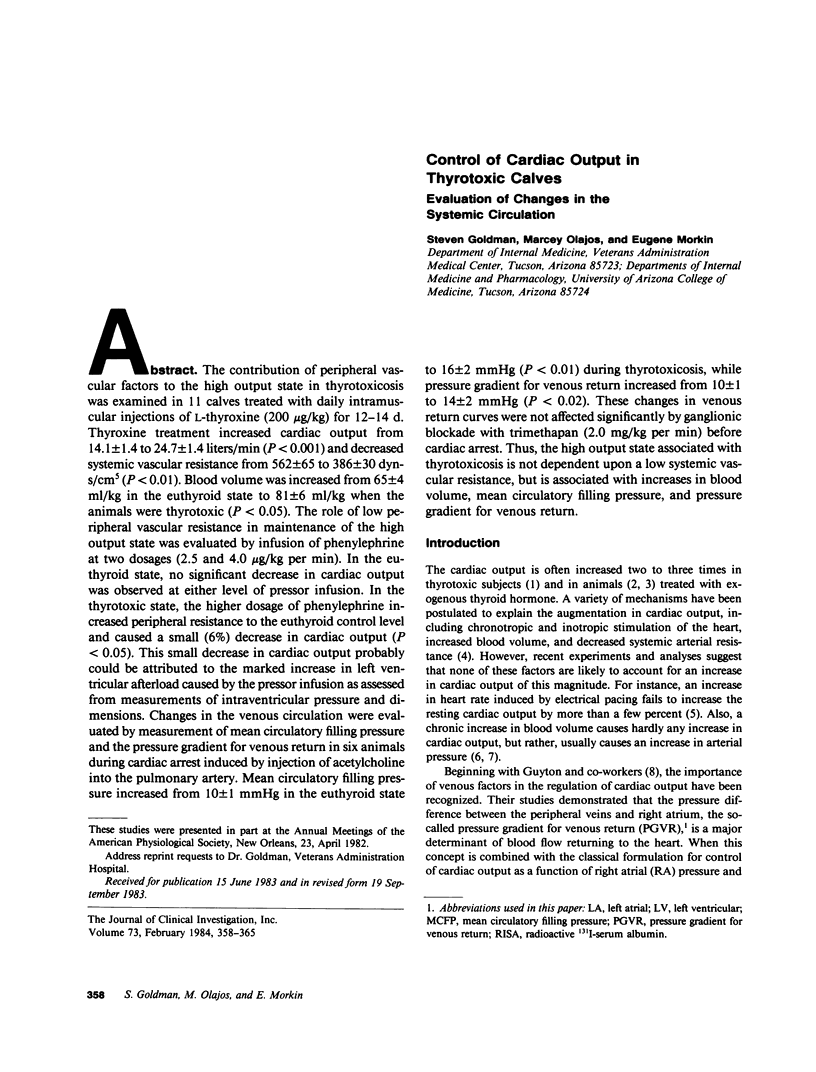


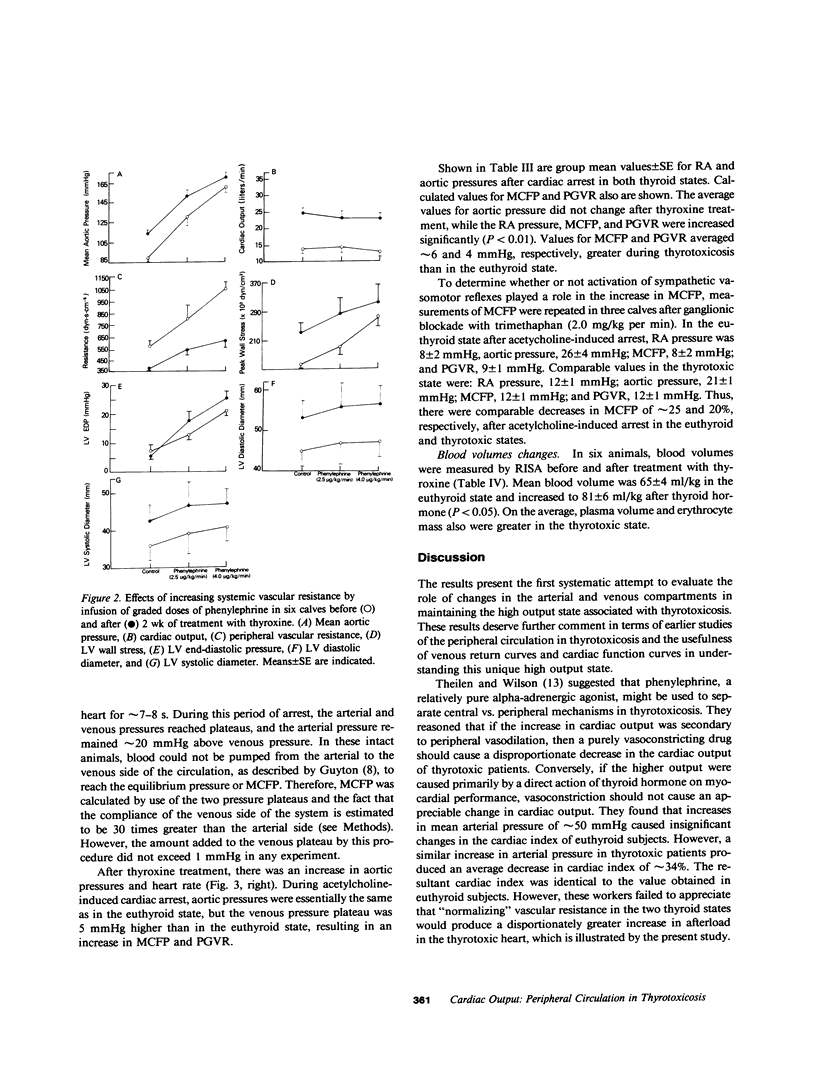
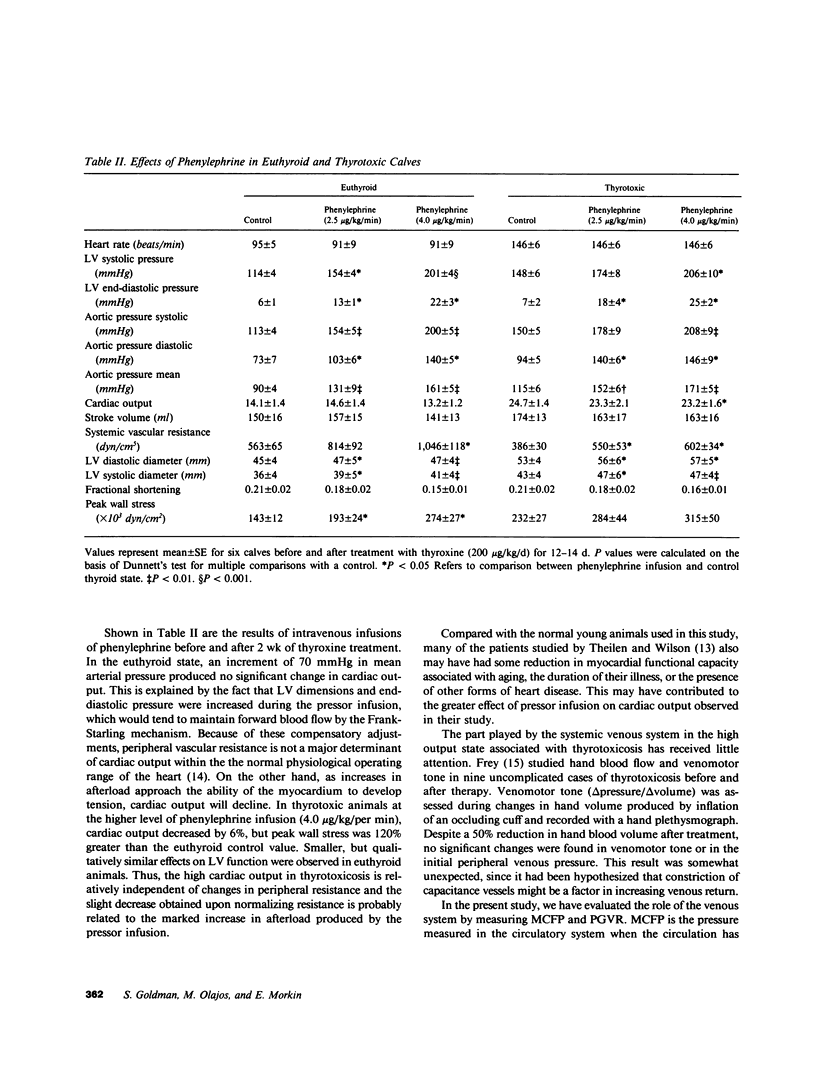
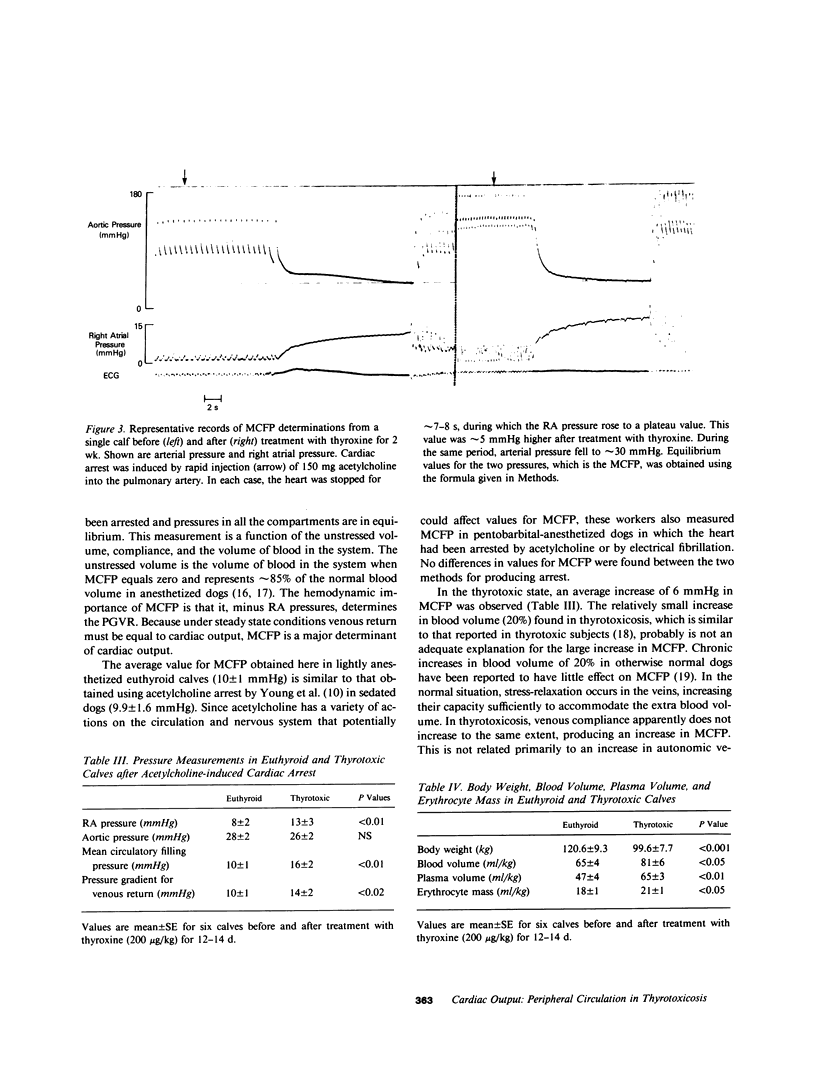
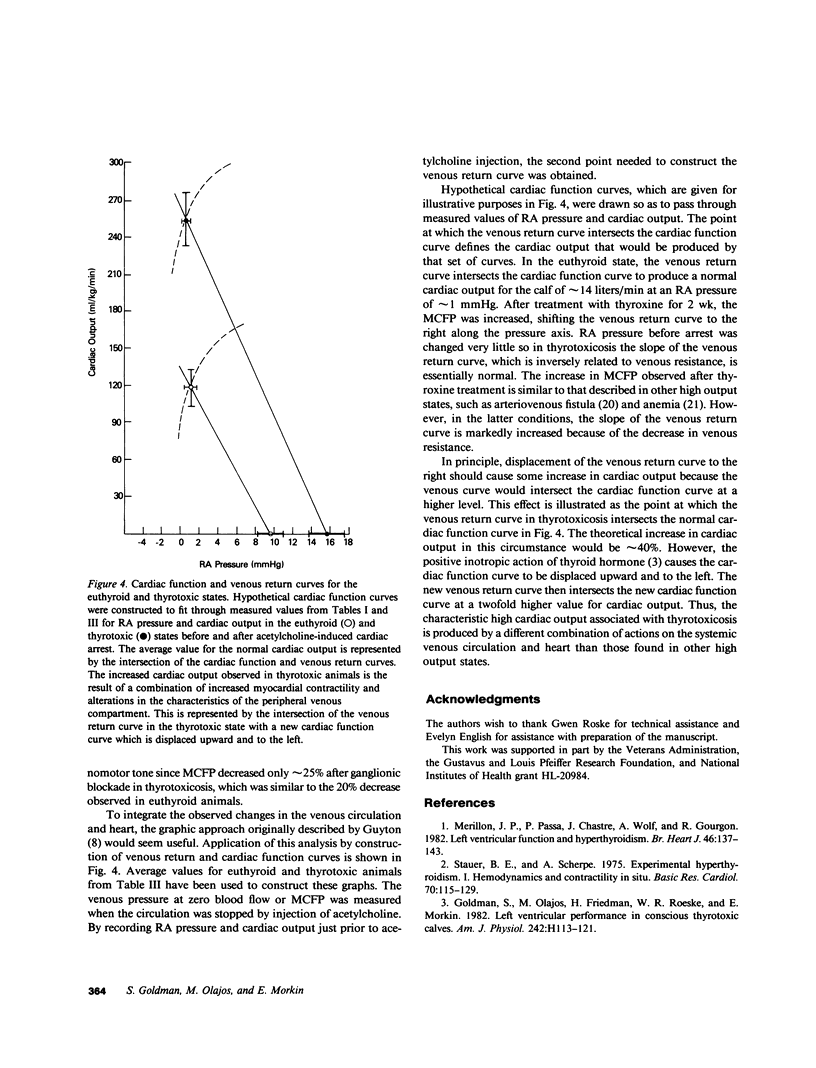
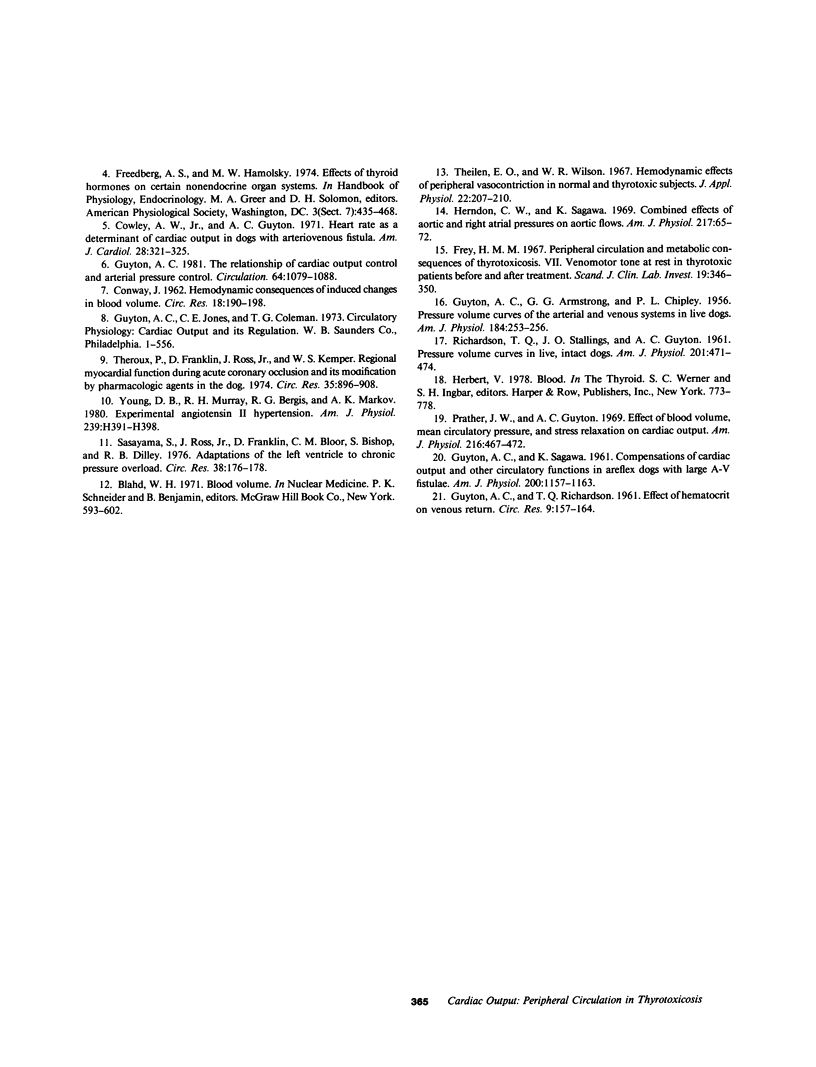
Selected References
These references are in PubMed. This may not be the complete list of references from this article.
- Cowley A. W., Jr, Guyton A. C. Heart rate as a determinant of cardiac output in dogs with arteriovenous fistula. Am J Cardiol. 1971 Sep;28(3):321–325. doi: 10.1016/0002-9149(71)90121-4. [DOI] [PubMed] [Google Scholar]
- Frey H. M. Peripheral circulatory and metabolic consequences of thyrotoxicosis. 8. Venomotor tone at rest in thyrotoxic patients before and after treatment. Scand J Clin Lab Invest. 1967;19(4):346–350. doi: 10.3109/00365516709090649. [DOI] [PubMed] [Google Scholar]
- GUYTON A. C., ARMSTRONG G. G., CHIPLEY P. L. Pressure-volume curves of the arterial and venous systems in live dogs. Am J Physiol. 1956 Feb;184(2):253–258. doi: 10.1152/ajplegacy.1956.184.2.253. [DOI] [PubMed] [Google Scholar]
- GUYTON A. C., RICHARDSON T. Q. Effect of hematocrit on venous return. Circ Res. 1961 Jan;9:157–164. doi: 10.1161/01.res.9.1.157. [DOI] [PubMed] [Google Scholar]
- GUYTON A. C., SAGAWA K. Compensations of cardiac output and other circulatory functions in areflex dogs with large A-V fistulas. Am J Physiol. 1961 Jun;200:1157–1163. doi: 10.1152/ajplegacy.1961.200.6.1157. [DOI] [PubMed] [Google Scholar]
- Guyton A. C. The relationship of cardiac output and arterial pressure control. Circulation. 1981 Dec;64(6):1079–1088. doi: 10.1161/01.cir.64.6.1079. [DOI] [PubMed] [Google Scholar]
- Herndon C. W., Sagawa K. Combined effects of aortic and right atrial pressures on aortic flow. Am J Physiol. 1969 Jul;217(1):65–72. doi: 10.1152/ajplegacy.1969.217.1.65. [DOI] [PubMed] [Google Scholar]
- Merillon J. P., Passa P., Chastre J., Wolf A., Gourgon R. Left ventricular function and hyperthyroidism. Br Heart J. 1981 Aug;46(2):137–143. doi: 10.1136/hrt.46.2.137. [DOI] [PMC free article] [PubMed] [Google Scholar]
- Prather J. W., Taylor A. E., Guyton A. C. Effect of blood volume, mean circulatory pressure, and stress relaxation on cardiac output. Am J Physiol. 1969 Mar;216(3):467–472. doi: 10.1152/ajplegacy.1969.216.3.467. [DOI] [PubMed] [Google Scholar]
- RICHARDSON T. Q., STALLINGS J. O., GUYTON A. C. Pressure-volume curves in live, intact dogs. Am J Physiol. 1961 Sep;201:471–474. doi: 10.1152/ajplegacy.1961.201.3.471. [DOI] [PubMed] [Google Scholar]
- Sasayama S., Ross J., Jr, Franklin D., Bloor C. M., Bishop S., Dilley R. B. Adaptations of the left ventricle to chronic pressure overload. Circ Res. 1976 Mar;38(3):172–178. doi: 10.1161/01.res.38.3.172. [DOI] [PubMed] [Google Scholar]
- Strauer B. E., Scherpe A. Experimental hyperthyroidism I. Hemodynamics and contractility in situ. Basic Res Cardiol. 1975 Mar-Apr;70(2):115–129. doi: 10.1007/BF01905613. [DOI] [PubMed] [Google Scholar]
- Theilen E. O., Wilson W. R. Hemodynamic effects of peripheral vasoconstriction in normal and thyrotoxic subjects. J Appl Physiol. 1967 Feb;22(2):207–210. doi: 10.1152/jappl.1967.22.2.207. [DOI] [PubMed] [Google Scholar]
- Theroux P., Franklin D., Ross J., Jr, Kemper W. S. Regional myocardial function during acute coronary artery occlusion and its modification by pharmacologic agents in the dog. Circ Res. 1974 Dec;35(6):896–908. doi: 10.1161/01.res.35.6.896. [DOI] [PubMed] [Google Scholar]
- Young D. B., Murray R. H., Bengis R. G., Markov A. K. Experimental angiotensin II hypertension. Am J Physiol. 1980 Sep;239(3):H391–H398. doi: 10.1152/ajpheart.1980.239.3.H391. [DOI] [PubMed] [Google Scholar]


